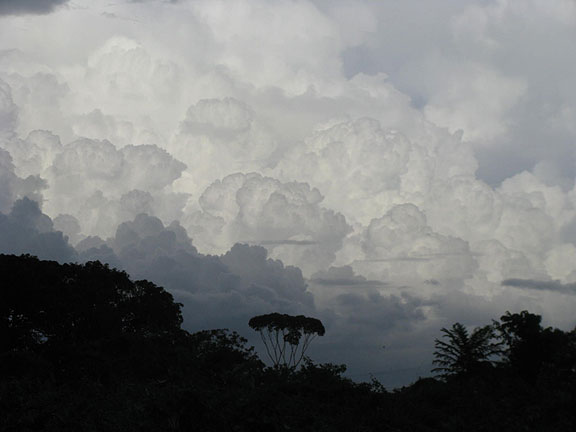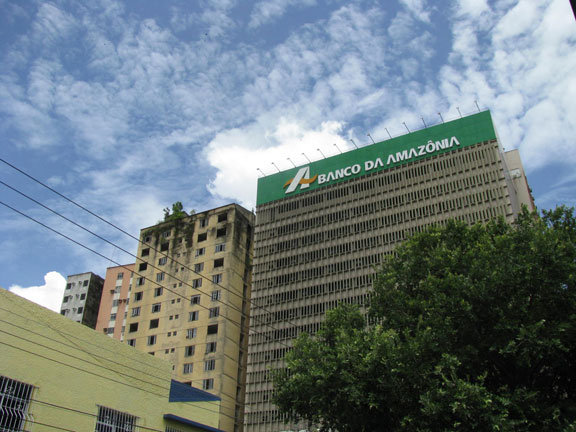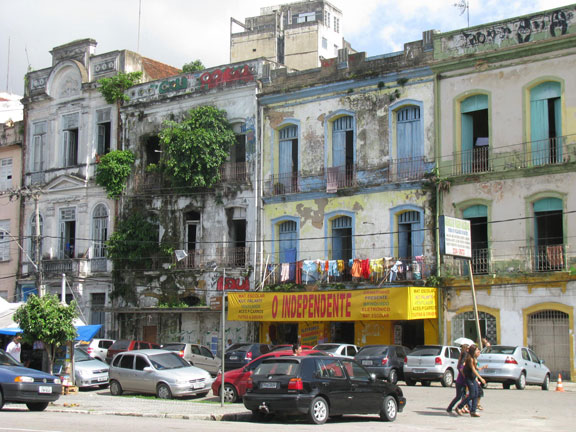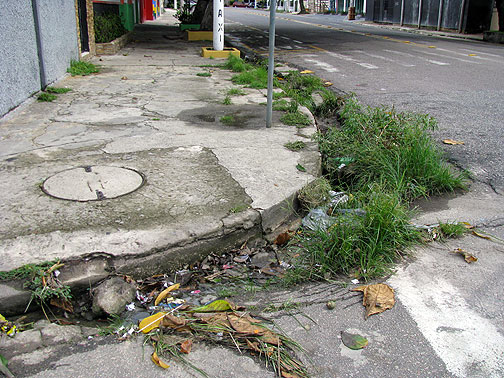
Great white herons soar among stained highrises, landing on mudflats to compete with vultures for the endless decay of a city that is always helplessly resisting humidification and flooding. At the edge of a forest of such breadth and density, the bird life in Belem is more than North American cities, but perhaps not as much as I’d expect, given the near surroundings. Small parakeets squawk incessantly in the ubiquitous mango trees, strange scruffy dove-like birds with very long tails sail from tree to tree, but not in great numbers. Yellow-bellied sparrows flit about in the Beaux Artes park squares, immaculately prepared for the thousands of guests that have descended on Belem. The sky itself is a grand partner in the panaromic welcome, taking the water from the vast basin beneath it to paint in colors and shapes that take your breath away with their vitality and intricacy.
The city of Belem is hosting the 9th World Social Forum (and 5th Pan-Amazon Social Forum to boot) as the self-proclaimed capital of Pan-Amazonia. It’s actually at the mouth of the Amazon river system in the Brazilian state of Pará, one of several states encompassing the continent-sized region, and that’s only the Brazilian part; according to the WSF declaration, this gathering is hosted by all the countries of Pan-Amazonia: Brazil, Bolivia, Colombia, Ecuador, French Guyana, Peru, Guyana Cooperative Republic, Surinam and Venezuela. Yep, size matters down here, and this is a small city in a very large area. I arrived two days before the beginning and it gave me some hours to acclimatize myself, both to the humidity and rain, and to the lovely sound of Portuguese (almost got it 20 years ago, now I can understand a smattering, quite useful but far from real comprehension). Most of the city was paved at one time, so though the water has relentlessly dug channels and sinkholes along every curb, sometimes precariously deep, it’s not as muddy or dusty is it might be. (This is an impossible town for independent wheelchair users!) Locals are very welcoming, happy to have visitors from afar (and plenty expect to enjoy the economic bounce we bring too), and proud to be the host city for an auspicious international gathering. On a bus ride from the center to the campus of the Federal University a charming woman sat next to me. Detecting that I could understand some of what she was saying, off she went, with recommendations for various beaches and places to eat, but I’m afraid I got only the most barebones idea of what she was telling me. Still, the spirit was great, and it made me happy that I could at least follow it a bit, responding appropriately a couple of times in my less-than-broken Portuguese.
My colleagues Kathy Wallerstein and Andrej Grubacic arrived last night and we went to the Praça da Republica for pizza and beer, meeting Andrej’s old friend Pablo, who turns out to be great pals with my Critical Mass co-conspirator from Sao Paolo Thiago (who also set us up with an apartment so we didn’t have to fight for a hotel). The weirdly moderne restaurant, where the waiters carefully serve the slices of pizza for you, was also the meeting spot of the Amazon activists whom I’d met at the Manaus airport. They were plotting an aerial SOS photoshoot for this morning, but as I guessed, we weren’t up in time to make it out to the campus where it was being staged. Instead, we’ll join the big opening march this afternoon. Word is that Lula, Evo Morales, and Hugo Chavez are all here to host the Forum! Not sure, but that’s the rumor, and it’s a bit embarrassing for those who remember the early days of the World Social Forum, when it was such an oppositional and energetic gathering, full of anti-institutional thinking and plotting. Now, frankly, it’s become rather staid, going by the program, a 150-page newspaper with endless listings in 8 pt type of various panels and discussions. It’s completely unwieldy, but worse, it’s also inaccurate. Of all the folks I’ve spoken with so far, hardly anyone has found their events listed in the catalog (including me”¦ at least Pablo, whom I met last night, knew I was going to be in a discussion with bicyclists from Sao Paolo” [p.s. I met them at the last minute as I was leaving the march yesterday evening and we’re on for 3 pm Friday” yay!]).

Downtown is not exempt from the relentless moisture reclaiming what it can.
My pal Jeff Conant and his colleague Marcella from Cochabamba, Bolivia, are here with the Red Vida (“Life network”) which is focused on water-as-commons, and they found their full day of panels and workshops to have been reduced to two listings on the errata sheet that helpfully appeared yesterday morning. Jeff’s book, “The Community Guide to Environmental Health,” is available online here, and is well worth a look. All the nuts and bolts of converting your community, whether rural or urban, to a thorough-going sustainability, and remarkably, every part of it has been field tested in at least five different countries and settings. The list of contributors is enormous. At a glance, I’d say this book is a great example of the kind of on-the-ground shift in sensibility that I’ve been talking about for a while with Nowtopia. We’re living through an epistemological shift towards a more integrated world view, where average folks understand on a deep level that we’re having to change how we live, and increasingly, the skills and knowledge that are required to pull that off are being broadly disseminated across the planet.
I mentioned in the previous entry’s comments that the bombing of Gaza has had quite an impact on a lot folks here. It came up quickly when I was waiting to change money at the bank in conversation with the South Africans, and later, I was watching the big TV channel here, O Globo, and they spent a full half hour on a mini-documentary on the effects of the bombing on people in hospitals, neighborhoods, and more, and showed white phosphorous smoldering and flaming on the ground, un-extinguishable by stamping on it. The TV reportage was such a contrast to what we see in the U.S., with reporters going right into the rubble, interviewing victims and survivors, none of whom were combatants or Hamas militants. The basic humanitarianism of the framing was quite direct, and puts the U.S. media to shame (not that it hasn’t long been a pathetic simulacra of “real news” anyway). Anyway, the two South Africans I chatted with were surprised that Americans were so jubilant and hopeful about Obama, since they saw him clearly as the latest “soft face of capitalism” and very much a product of and servant to the ruling class. Perhaps they’re not so easily taken in by the idea that his race is equivalent to real change. (I heard a horrifying anecdote: thousands of white people in DC at the inauguration wearing buttons that said “I [heart] black people”!!?? ack! Can this be true? If it is, how can thousands of people be so unconsciously condescending and stupid and not realize it?)”¦

On the riverfront, life and decay coexist...
Been reading McKibben’s Deep Economy and his chapter on “The Year of Eating Locally” provided a plethora of wonderful statistics. I’ve been speaking about urban gardening and food forests to friends and Nowtopia audiences for quite a while, and generally relying on the old stat that more than 40% of the fresh produce eaten by Americans at the end of WWII came from urban gardens. McKibben has documented several 21st century stats: Shanghai, the world’s biggest city, gets 60% of its vegetables and 90% of its milk and eggs from urban farms. A recent study estimates that London could produce 20% of the fruit and vegetables needed by its 10 million residents on the 10% of farmland left among its sprawl. Take it a step further to the idea of “One Lane for Food” and imagine if we start converting parts of asphalted roads, pointlessly wide, housing private autos on public lands, to linear farms”¦ add that to the existing networks of urban gardens and backyard orchards and we could start to approach a systematic urban food program that really could reinvent our lives. McKibben goes a lot further, debunking the notion that small urban farms are insufficiently productive, and shows the contrary, that they are more productive than large agribusiness fields farmed by lone machine drivers. Havana, Cuba is one of the best recent examples of a full-size city making the transition to local, sustainable, urban farming for its sustenance, but McKibben also shows how the rise of CSAs, farmer’s markets, and a panoply of new urban farming initiatives are reclaiming wrecked lands, restoring soil and water health, and becoming the starting point for a whole economic rejuvenation in many places, from Vermont to Wisconsin to Oregon (we certainly have experienced a version of the same in the Bay Area). Of course the key to this is labor intensive, small-scale farming. And “labor-intensive” might sound offensive to some, but if you consider the pointlessness and alienation and sheer ennui that define most jobs, you can put this New Food Agenda together with a critique of wage-labor to start shaping a real agenda for change”¦ no?

Not for the wheelchair users! Barely for pedestrians and cyclists!












Leave a Reply